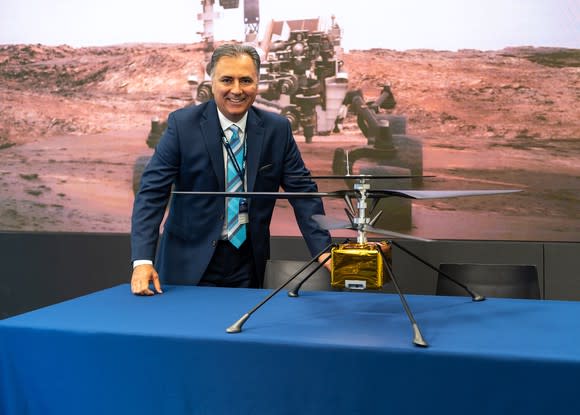Drones on Mars? AeroVironment Will Help NASA to Make It So
In just a little over two years, NASA will launch a new unmanned mission to Mars. At a cost of $2.1 billion, Mars 2020, as the mission is called, will be cheaper than NASA's Curiosity rover expedition that landed in 2012. Despite the bargain price, Mars 2020 will carry with it something that Curiosity didn't: a flying drone.

"Mars needs drones!" (And AeroVironment will build them). AeroVironment CEO Wahid Nawabi showcases a model of the planned Mars Helicopter. Image source: AeroVironment.
Speeding things up on Mars
Exploring Mars is important work -- but it's not speedy work. The top speed of NASA's Curiosity rover, for example, is less than 1/10th of a mile per hour. Since landing on Mars in early August 2012, NASA reports, Curiosity has traveled a grand total of less than 12 miles. Thus, Curiosity is trundling along at the leisurely pace of roughly 2 mpy (miles per year). By tucking a drone aboard the Mars 2020 rover, however, NASA hopes to speed things up a bit to get out and see more stuff.
There is, however, one difficulty with flying drones on Mars: air -- or rather the lack of it.
At surface level, Mars' atmospheric density is roughly equal to the density of Earth's atmosphere at an elevation of 100,000 feet -- roughly four times the height of Mount Everest. Since drones require air to provide the lift that permits flying, this poses a problem. Fortunately, there's one company that has some experience building drones that fly at such rarefied heights.
NASA calls the drones specialist
In 2001, AeroVironment (NASDAQ: AVAV) built and flew for NASA its Helios Prototype drone -- a lightweight solar-powered flying wing with a wingspan of 247 feet -- to an unofficial world-record altitude of 96,863 feet, where it flew for more than 40 minutes. That experience makes AeroVironment arguably the company best suited to build drones capable of flying in Mars' exceedingly thin atmosphere as well.
And so, as explained in a press release last week, NASA and its Jet Propulsion Laboratory (JPL) have hired AeroVironment. The announcement said that the company was chosen to develop and produce an "airframe and major subsystems, including ... rotor, rotor blades, hub and control mechanism hardware" for a flying helicopter-like drone for use on Mars. JPL will provide the drone's avionics, sensors, and software systems.
Already, AeroVironment has helped JPL build two test-flight versions of the Mars 2020 drone, now dubbed the Mars Helicopter. And it's currently building the actual flight versions that will travel to Mars in 2020 and land there in 2021.
What it means to investors
To anyone who grew up reading Edgar Rice Burroughs' or Robert Heinlein's tales of machines soaring through the skies of Barsoom (Mars), this is grand news all on its own. But it's even better news for investors in AeroVironment stock, which came under savage attack last year from short-seller Spruce Point Capital, which criticized everything from AeroVironment's weak profits, to how it accounted for them, to the motivations of its management.
A vote of confidence from NASA could go a long way toward dispelling that -- and to filling AeroVironment's coffers as well. Here's why:
According to SpaceNews.com, the Mars 2020 mission is likely to cost roughly $2.1 billion to develop, build, and launch. Presumably, AeroVironment's Mars Helicopter will represent just a small portion of that initial cost. But once on Mars, SpaceNews estimates, NASA will be spending $300 million per Martian year to fund operations of the Mars 2020 rover, and its drone.
That's roughly $160 million per Earth year. And while, again, it's unlikely AeroVironment's share of this money will be great, it will surely be something. (NASA can hardly be expected to operate a novel piece of equipment like the first drone on Mars without some help from the company that built most of the drone's parts.)
How much money might we be talking about here? I don't know for sure. But it wouldn't take much to move the needle for AeroVironment, which recorded revenues of less than $230 million last year, according to data from S&P Global Market Intelligence. In addition to whatever the company earns from building the Mars Helicopter in the first place, for every 2% of Mars 2020's operating budget that AeroVironment captures, its own revenue stream will grow by more than 1%.
And then there's the publicity value. Again, I don't know how you put a price tag on the reputation points AeroVironment will score from building the only aircraft ever to fly on Mars -- and of having its name mentioned every single time NASA announces a new discovery by the Mars Helicopter.
That kind of publicity is probably priceless -- and for AeroVironment shareholders, this is literally out-of-this-world good news.
More From The Motley Fool
Rich Smith has no position in any of the stocks mentioned. The Motley Fool recommends AeroVironment. The Motley Fool has a disclosure policy.

 Yahoo Finance
Yahoo Finance 